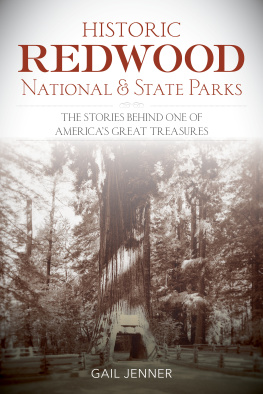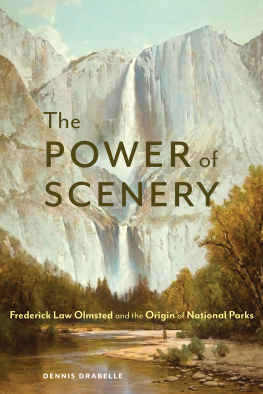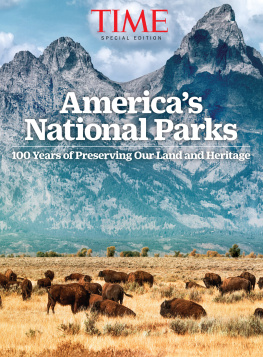Historic Redwood National and State Parks
Also by Gail L. Jenner
Ankle High and Knee Deep: Women Reflect on Western Rural Life
Western Siskiyou County: Gold & Dreams
Images of the State of Jefferson
The State of Jefferson: Then & Now
Postcards from the State of Jefferson
Historic Inns and Eateries in the State of Jefferson
Across the Sweet Grass Hills , Winner of the 2002 WILLA Literary Award
Black Bart: The Poet Bandit
Historic Redwood National and State Parks
The Stories Behind One of Americas Great Treasures
Gail L. Jenner


An imprint of Rowman & Littlefield
Distributed by NATIONAL BOOK NETWORK
Copyright 2016 by Rowman & Littlefield
All rights reserved. No part of this book may be reproduced in any form or by any electronic or mechanical means, including information storage and retrieval systems, without written permission from the publisher, except by a reviewer who may quote passages in a review.
British Library Cataloguing in Publication Information Available
Library of Congress Cataloging-in-Publication Data is available on file.
ISBN 978-1-4930-1809-3 (paperback)
ISBN 978-1-4930-1810-9 (e-book)
 The paper used in this publication meets the minimum requirements of American National Standard for Information SciencesPermanence of Paper for Printed Library Materials, ANSI/NISO Z39.48-1992.
The paper used in this publication meets the minimum requirements of American National Standard for Information SciencesPermanence of Paper for Printed Library Materials, ANSI/NISO Z39.48-1992.
Contents
Introduction
As one travels US Highway 101, what was once called the Redwood Highway, its easy to overlook the real impact of the redwoods. Yes, many people stop and stare up at a few of the taller, more impressive trees along the highway. Or, maybe theyll take one of the loops through the trees and marvel at themfor a few miles anywayand hug a tree or two as they snap photos on their phones or cameras.
But, when you truly get off the beaten track and immerse yourself in the deep shade and overwhelmingly peaceful and stunning world found within, under, and around the Tall Trees, it takes your breath away. In the silence you have to sigh and inhale deeply; even the scent of the trees and abounding undergrowth awakens the deepest part of your nature. Finally you begin to sense the otherworldly character of these ancient, massive trees. They speak of time and the passage of time. Some are six hundred years old; some are a thousand years old. A few are, perhaps, two thousand years old. Some stand over 350 feet tall, with a girth of 15 or 20 feet. Whatever their height or breadth, however, they are magnificent. They are awe-inspiring, and they speak of a past cloaked in mystery and rich history.
Such is the captivating world found within and around the Redwood National and State Parks (RNSP) located in the far northwestern corner of California. A federal park, the four parks that make up the Redwood National and State Parks fall under the jurisdiction of the National Park Service (NPS) while cooperatively managed by NPS and the California Department of Parks and Recreation (CDPR).
This breathtaking world is a unique one and the parks eventual designation was won only after much controversy and debate. Those who pursued protection of the great trees persevered despite great challenges.
After the initial purchase of 166 acres, which became Prairie Creek Redwoods State Park in 1923, and the eventual creation of Redwood National Park in 1968, conservationists as well as a concerned public have continued to push for greater protection of Californias redwoods. Moreover, today the National Park Services goal of preservation is linked to its secondary, long-range goal of restoration. As noted in the parks General Management Plan/General Plan (2000), [the ultimate goal] is to restore and maintain the RNSP ecosystems as they would have evolved without human influences since 1850 and perpetuate ongoing natural processes.
In truth, however, the physical history of the region is linked to the history of the various and distinct human populations that have interacted with it, from pre-contact times to the present. This impact has left its indelible imprint on the land and the environment, and to appreciate the story of the Redwood National and State Parks evolution and creation, it is important to look at the scope of human history, as well.
There are few words that can adequately describe what the redwoods mean to the people who have spent generations living as part of them. Taking a step backwards in time to when the original people of the forests lived within the redwood coastal belt reveals just how connected their lives were to the environment they occupy. Their lives wereand arebuilt on more than just the wood, although the redwood was the source of much of their material culture; their lives were enmeshed in the very character and fabric of the trees.
The trees lived and breathed life into them. As Minni Reeves, Chilula tribal elder and religious leader, Hupa Indian Reservation, said in an interview in 1976, the Chilula are the people from within the redwood tree. To the Yurok, redwood trees are living beings that stand as guardians over sacred places.
Finally, according to Edwin C. Bearss in Redwood National Park: History/Basic Data , a house, to the coastal tribes, was understood to be a living being. The redwood that formed its planks was itself the body of one of the Spirit Beings. Spirit Beings were believed to be a divine race who existed before humans in the redwood region and who taught people the proper way to live here. Even those who spent their lives in the forest as woodsmen and loggers found a source of strength deep within these dense forestsnot comprehending, perhaps, the scope of their destruction, but loving the trees all the same.
Though redwood forests originally covered up to two million acres, Redwood National Parkalong with three California State Redwood Parks, including Del Norte Coast Redwoods State Park, Jedediah Smith Redwoods State Park, and Prairie Creek Redwoods State Parkcurrently protect 131,983 acres (federal: 71,715; state: 60,268). And because more than 90 percent of the redwoods that once ranged from above the Oregon border down to the central California coastline are gone now, Redwood National and State Parks is even more important than as just a tourist destination.
E. C. Williams, one of the first men to pursue the commercial value of redwood, reminisced in 1912 about his first journey through the redwood wilderness in the spring of 1850. He remarked that the groves of redwoods were, in fact, Gods first temples, as declared in Bryants Thanatopsis .
In retrospect, Williams also wrote, I cannot but regret the part it appeared necessary for me to enact in what now looks like a desecration. Perhaps, with hindsight being 20/20, we recognize how seriously we must take the preservation of the redwoods. It is not just for the present we protect the redwoods, nor is it just to preserve the pastit is for the future. The future of mankind...
As Minni Reeves so elegantly explained: The redwood trees have a lot of power: they are the tallest, live the longest, and are the most beautiful trees in the world. Destroy these trees and you destroy the Creators love. And if you destroy that which the Creator loves so much, you will eventually destroy mankind.
Acknowledgments
In putting together this book, it seemed impossible to separate the Redwood National and State Parks history from the general history of the Tall Trees through time: how they evolved, how the first people interacted with them, how the environment as well as the corresponding flora and fauna relied on them, how industries grew up dependent upon them, and how those who recognized their importance worked to preserve them. These smaller chapters seem to pre-date the actual history of the movement to create the Redwood National and State Parks and thus, I am including them in this history as well.
Next page









 The paper used in this publication meets the minimum requirements of American National Standard for Information SciencesPermanence of Paper for Printed Library Materials, ANSI/NISO Z39.48-1992.
The paper used in this publication meets the minimum requirements of American National Standard for Information SciencesPermanence of Paper for Printed Library Materials, ANSI/NISO Z39.48-1992.